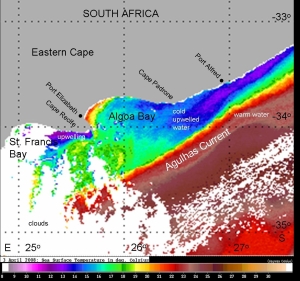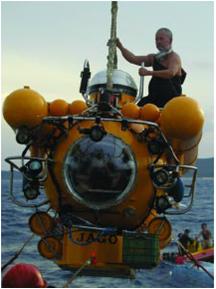SAEON Egagasini
|
A set of marine-offshore observation platforms is currently being developed, implemented and coordinated at the Node, and the development of the Algoa Bay offshore component is being discussed with the Elwandle Node (Picture © Wayne Goschen) |
|
SAEON Egagasini is engaged in discussions with the African Coelacanth Ecosystem Programme (ACEP) on the structure of data storage and dissemination of ACEP data (Pictures © ACEP) |
|
Thomas Mtontsi, Egagasini’s Education Outreach Officer, is currently on the SA Agulhas to take part in a five-week logistical and oceanographic cruise to the Prince Edward Islands. This will improve his knowledge and hands-on experience of all different aspects of offshore marine work (Picture © Jongikaya Mdumata) |
In the first four months of 2008 the SAEON Egagasini Node for Marine-Offshore Systems experienced several milestones.
Last month SAEON won a coveted Prism Award at the Public Relations Institute of Southern Africa’s Awards function. This was for the launch of the Egagasini Node during the Group on Earth Observations’ Ministerial Summit in November last year.
Another highlight is a business plan that is under development for the Node. A successful first strategic planning session was held with the Egagasini team, who all gave feedback on the first draft of the business plan.
Human Resources matters
The SAEON Egagasini Node is now running with a full complement of staff: Dr Juliet Hermes – Node Manager, Wayne Goschen - Data Scientist and Oceanographer, Thomas Mtontsi - Education Outreach Officer, and Penelope Price - Scientific and Support Officer.
SAEON Egagasini recently awarded a fellowship in physical oceanography in collaboration with Prof Johann Lutjeharms of (UCT) to Dr Raymond Roman. Dr Roman’s contract with SAEON has been signed and he will start work on his postdoc on his return from the Prince Edward Islands.
Thomas Mtontsi left Cape Town on the 25th of March on the SA Agulhas, South Africa’s only Antarctic research and supply vessel, to take part in a five-week logistical and oceanographic cruise to the Prince Edward Islands. This will undoubtedly improve his knowledge and hands-on experience of all different aspects of offshore marine work, as well as giving him a once in a lifetime opportunity to visit Marion Island. A full report will be submitted on his return and will be made available on the SAEON Egagasini website.
Effects of Climate Change on the World’s Oceans
Juliet will be attending an International Symposium on “The effects of Climate Change on the World’s Oceans” in Gijón, Spain from 19 – 23 May. The Symposium will focus on the major issues of climate change that affect the oceans: oceanic circulation, climate modelling, cycling of carbon and other elements, acidification, oligotrophy, changes in species distributions and migratory routes, sea-level rise, and coastal erosion. It will bring together results from observations, analyses and model simulations at a global scale, and will include discussion of the climate change scenarios and the possibilities for mitigating and protecting the marine environment and living marine resources.
Securing, integrating and disseminating long-term datasets
A set of marine-offshore observation platforms is currently being developed, implemented and coordinated at the Node, and the development of the Algoa Bay offshore component is being discussed with the Elwandle Node.
Apart from developing offshore Algoa Bay data and monitoring plans, Wayne Goschen has been working with Marine and Coastal Management (MCM) on a number of projects. Wayne is also engaged in ongoing discussions with Lucy Scott of the African Coelacanth Ecosystem Programme (ACEP) and Laurent Drapeau of the Institut de Recherche pour le Développement (IRD), on the structure of data storage and dissemination of ACEP data.
Wayne attended the South African Estuaries Database workshop at the Elwandle Node, where he was able to give significant advice on the technical aspects of the database. He also attended the International Conference on Marine Data and Information Systems (IMDIS) in Greece, where he presented a poster.
Wayne attended a meeting with Wim Hugo, SAEON’s ICT consultant and Dr Nicky Allsopp, Manager of the SAEON Fynbos Node to further investigate the problems with the CoGIS system and seek the best solutions.
Dr Johan Augustyn of MCM contacted the Egagasini Node with a request to look at ship’s data DDS/NDS systems (Data Distribution System/Network Distribution System). Wayne and Juliet attended meetings with Phillip de Bruyn and Ashley Naidoo (both of MCM), and Wayne followed this up with a meeting with Patrick Foley (MCM), where it was resolved that Egagasini and MCM should set up a database for the ship’s historical and current data, with internet access (so live cruises can look at past cruises). At the same time, the data could then be analysed for any defects and inconsistencies, and reports written with recommendations on the best path to take to get clean ship’s data. Wayne now has a sample data set to work on further developments.
Developing marine science education outreach programmes
There has been a considerable amount of education and awareness outreach these past few months, all of which has been very successful.
Thomas Mtontsi, the Node’s Education Outreach Officer has written a first draft educational plan entitled ‘Conducting outreach differently, to make a difference’. Sibongile Mokoena, SAEON’s National Education Outreach Coordinator spent three days at the Node to assist Thomas to refine the education plan.
During this time Thomas and Sibongile also attended a meeting with the education outreach team of the South African National Biodiversity Institute (SANBI). The meeting was aimed at exploring possible synergies between SAEON Fynbos Node (which was recently established) and SANBI education outreach.
During Sibongile’s visit, Penny organised a visit to the Scholar Ship, along with a number of (LEAP School) learners. The visit was a great success. Next year, when the Scholarship docks in Cape Town once again, Egagasini will have developed a more structured education outreach programme. The Node is still awaiting feedback from the students who attended the course on board the Scholar Ship, but feedback thus far has been positive. As part of the excursion, free entrance to the Two Oceans Aquarium was organised by Thomas, which proved to be a huge success with the LEAP School learners.
In Thomas’s absence, Penelope Price worked with the LEAP School learners on a production for South Africa’s National Festival for Science, Engineering and Technology (Scifest ) on how to build a habitable planet. Penny ended up running the whole project, providing scientific and artistic input, as well as logistics for stopovers on the way. Juliet, who attended one of the dress rehearsals, described the performance as “excellent”.
Thomas is still awaiting feedback on his proposal to the South African Agency for Science and Technology Advancement (SAASTA) for Antarctica Month. Whilst on board the Agulhas, Thomas will forge strong relations with Southern Ocean scientists, which will strengthen the work he will do during Antarctica Month.
Thomas has submitted a proposal to a developing Cape Town Community Television Station for an Environmental Science Education Programme of 10 – 48 episodes where different topics will be discussed. He is still awaiting the outcome. This will be a very important way to facilitate the building of scientist–educator–layperson relationships. The title of the proposal uses the term ‘Amaz’olwazi’, roughly translated as ‘waves of knowledge’.





